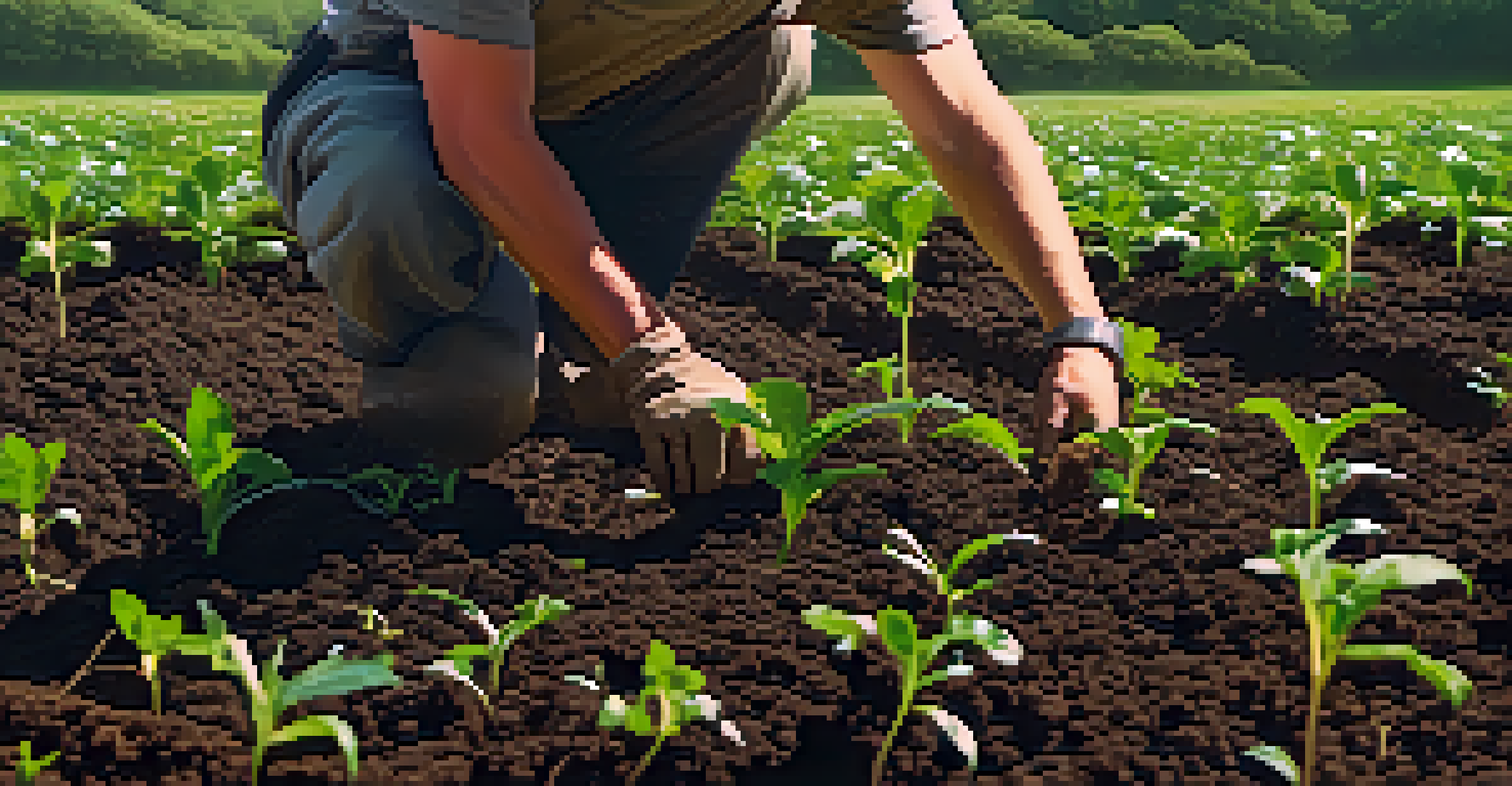Regenerative Agriculture: A Solution for Ayahuasca Cultivation

Understanding Regenerative Agriculture and Its Benefits
Regenerative agriculture is a holistic approach to farming that focuses on restoring soil health and biodiversity. Unlike conventional farming, which often depletes resources, regenerative practices aim to create a self-sustaining ecosystem. This method not only enhances crop yields but also improves resilience against climate change.
The health of our soil is the foundation of our health as a society, our economy, and our environment.
By integrating techniques like cover cropping, crop rotation, and agroforestry, farmers can enhance the natural processes that help maintain soil fertility. This is particularly crucial for crops like ayahuasca, which thrive in rich, diverse environments. The benefits extend beyond the farm, contributing to healthier ecosystems and communities.
Moreover, regenerative agriculture can lead to economic advantages for farmers. Healthier soils can reduce the need for chemical fertilizers and pesticides, lowering input costs. This approach not only supports sustainable practices but can also yield higher profits over time.
The Unique Needs of Ayahuasca Cultivation
Ayahuasca, derived from the Banisteriopsis caapi vine and other plants, requires specific growing conditions to flourish. This mystical plant is often cultivated in the Amazon rainforest, where the ecosystem supports its unique needs. However, overharvesting and unsustainable practices have threatened its natural habitat.

To ensure a sustainable supply of ayahuasca, it’s vital to understand its growth requirements, such as soil quality, moisture, and companion plants. Regenerative agriculture can create a balanced ecosystem that supports these needs while preserving the environment. This approach emphasizes the importance of biodiversity, which can help combat pests and diseases naturally.
Regenerative Agriculture Benefits
This holistic farming approach restores soil health and biodiversity while enhancing crop yields and resilience to climate change.
Additionally, cultivating ayahuasca sustainably can help preserve indigenous knowledge and practices. By respecting and integrating traditional farming methods with modern regenerative techniques, we can create a more holistic approach to ayahuasca cultivation.
How Regenerative Practices Support Biodiversity
Biodiversity is crucial for the health of any ecosystem, and regenerative agriculture plays a key role in enhancing it. By promoting a variety of crops and plants, farmers can create habitats that attract beneficial insects and wildlife. This diversity can help control pests and improve pollination, leading to healthier ayahuasca plants.
Biodiversity is essential for the resilience of ecosystems; the more diverse the system, the more stable it is.
For instance, integrating cover crops can provide food and habitat for pollinators while simultaneously enriching the soil. These practices not only benefit the ayahuasca crop but also contribute to the overall health of the ecosystem. A rich biodiversity can help mitigate the effects of climate change, making crops more resilient.
Moreover, preserving native plant species is essential for maintaining the cultural significance of ayahuasca. Many indigenous communities rely on these plants not just for their psychoactive properties but also for their medicinal uses. By fostering biodiversity, we can honor these traditions while ensuring the future of ayahuasca cultivation.
Soil Health: The Foundation of Regenerative Agriculture
Soil health is often overlooked, yet it’s the cornerstone of successful agriculture. Regenerative practices focus on improving soil structure, increasing organic matter, and enhancing microbial activity. Healthy soil not only supports robust plant growth but also plays a vital role in carbon sequestration, helping to combat climate change.
For ayahuasca cultivation, rich, nutrient-dense soil is essential. Techniques such as composting, mulching, and reduced tillage can significantly improve soil health. By promoting a diverse range of soil organisms, farmers can create an environment where ayahuasca and other plants can thrive.
Sustainable Ayahuasca Cultivation
Understanding the specific growth needs of ayahuasca is crucial for sustainable practices that preserve both the environment and indigenous knowledge.
In turn, healthier soils contribute to better water retention and reduced erosion, making the entire farming system more sustainable. By prioritizing soil health, we can ensure a consistent and high-quality yield of ayahuasca while preserving the environment for future generations.
Water Management in Regenerative Agriculture
Water management is a critical aspect of agricultural sustainability, particularly in regions where ayahuasca is grown. Regenerative agriculture emphasizes practices that enhance water retention and reduce runoff. Techniques like contour farming and the construction of swales can help capture and store water effectively.
For ayahuasca, which often grows in humid, tropical climates, maintaining adequate moisture levels is vital. By implementing regenerative practices, farmers can create a landscape that supports water conservation. This not only benefits the plants but also reduces the risk of drought during dry seasons.
Additionally, improved water management can lead to healthier ecosystems. By minimizing water pollution and encouraging groundwater recharge, regenerative agriculture helps maintain the delicate balance of local waterways. This is crucial for sustaining the biodiversity that supports ayahuasca cultivation.
Economic Viability of Regenerative Ayahuasca Farming
Transitioning to regenerative agriculture can seem daunting, especially for ayahuasca farmers accustomed to conventional methods. However, the long-term economic benefits are significant. By reducing reliance on chemical inputs and focusing on sustainable practices, farmers can lower their costs and increase their profit margins.
Moreover, regenerative practices often lead to higher-quality crops, which can command better prices in the market. As consumers become more aware of sustainability, they are increasingly willing to pay a premium for products grown using eco-friendly methods. This trend presents an opportunity for ayahuasca farmers to capitalize on their commitment to sustainability.
Economic Advantages of Regeneration
Transitioning to regenerative agriculture can lower costs and open new markets due to the rising consumer demand for sustainably sourced products.
Additionally, regenerative agriculture can open doors to new markets, such as organic and ethically sourced products. By promoting their practices and the unique qualities of their ayahuasca, farmers can attract a broader customer base that values sustainable and responsible sourcing.
The Future of Ayahuasca Cultivation Through Regeneration
Looking ahead, the future of ayahuasca cultivation can be bright with the adoption of regenerative practices. By focusing on sustainability, farmers can ensure a stable supply of this revered plant while protecting the environment. This approach not only meets the growing global demand for ayahuasca but also honors the cultural heritage associated with its use.
Furthermore, as more farmers adopt regenerative methods, we can expect to see a shift in agricultural practices worldwide. This collective movement can lead to a healthier planet, enhanced biodiversity, and stronger communities. The ripple effects of these changes can empower local economies and promote resilience against environmental challenges.

Ultimately, the integration of regenerative agriculture in ayahuasca cultivation serves as a model for other crops and farming systems. By prioritizing the health of our planet and the communities that depend on it, we can create a sustainable future for generations to come.